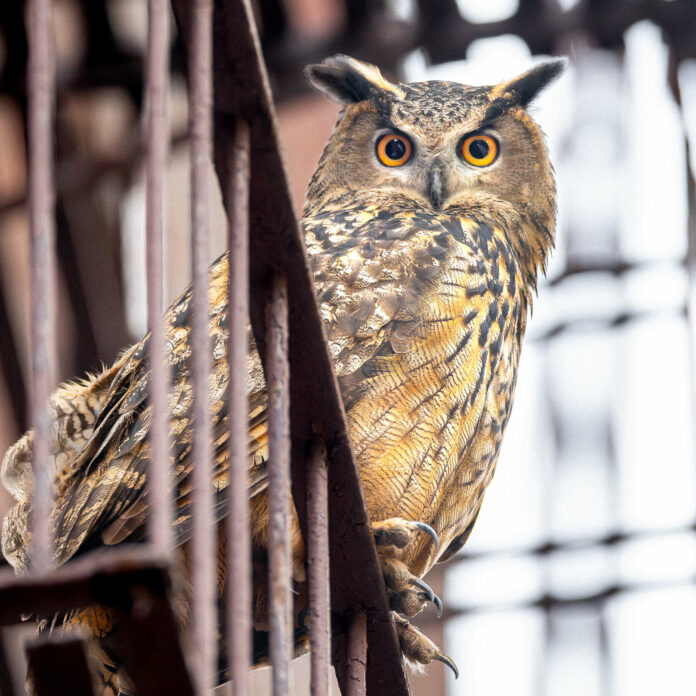Can you remember the last time a consumer of rats merited an obituary in The New York Times? Me neither. But the recent demise of Flaco was front-page news.
Flaco, for anyone who may have been focused on less-urgent happenings of late, was a Eurasian eagle owl who, just over a year ago, after his Central Park Zoo enclosure was vandalized, escaped into the urban wilds. His peregrinations captured the attention of countless citizens, and sightings of the bird were breathlessly reported by sudden amateur ornithologists.
And his untimely death, apparently after an unexpected high-speed meeting with a midtown Manhattan building window, prompted an outpouring of citywide, even nationwide, emotion. People gathered to pay their respects at one of Flaco’s favorite trees in the park. Some left bouquets, poems, toy owls and condolence cards, one of which read: “You moved us all. We loved you so much. We are so glad you had a year of freedom.”
Artist Calicho Arevalo told ABC News that he spent many hours painting a Lower Manhattan street mural honoring his avian inspiration.
“For me,” Mr. Arevalo explained, “it’s more the story of an immigrant or someone not from the city, and then [he] flies free and finds his instincts to trust himself and survive.”
Carl Safina, a professor at the State University of New York at Stony Brook, saw in Flaco’s fate “a chance to reckon with the question at the heart of many a hero’s journey: Can we put a price on freedom?”
“Flaco,” he philosophized, “never looked back… never retreated to the zoo. Perhaps freedom itself was the home he’d discovered.”
“How many of us,” the professor mused, “our circumstances familiar and safe, are too timid to seek our more fully realized selves?”
If you picked up my less-than-grief-stricken tone, please don’t misinterpret it as avianphobic. I have a lifelong fascination with animals; and the Shafran home, over the years, has been the home of hamsters, a goat, an iguana, a tarantula—the latter three were Purim gifts long ago from talmidim with an unusual sense of humor—and, even today, an assortment of tropical fish.
And my current abode abuts a large tract of forestland, the Staten Island Greenbelt. When the occasional field mouse from the woods finds its way into our house, my wife and I set a humane trap and take care to relocate the furry fellow to his natural habitat. (Mice have impressive homing skills, and so I, my wife and Mendel make an outing of it, driving a mile or so away to release the captive in a fresh field.)
And I’m all in favor of modifying high windows to keep birds from thinking it’s open sky, not glass, toward which they are flying.
But, in the end, one can deeply care about animals without anthropomorphizing them, imagining them as human.
Flaco’s survival in New York after living the first 12 years of his life in captivity is noteworthy, but only as a testimony to the resilience with which Hashem has imbued living creatures (including us). Not, though, as evidence of the virtue of courage or the value of freedom.
My quibble might seem minor, but in a world like ours, where some increasingly seek to blur the line between human and animal—whether by embracing the “freedom” to act without restraint or by championing “animal rights” to the point of vilifying those who eat meat, it’s not. Especially when there are laws in some countries that effectively outlaw shechitah on the grounds of animal welfare. Most recently, the European Court of Human Rights upheld two Belgian regions’ requirement to “stun” animals before slaughter.
The Torah forbids tzaar baalei chayim, causing animals unnecessary pain. At the same time, though, it explicitly considers animals to be entirely subject to the needs of humans.
While it must be accomplished in as painless a way as possible, utilizing animals for work and even killing them for food or leather is entirely acceptable.
And so, to counterbalance the widespread mourning of Flaco and celebration of his life as exemplary of high human ideals, it is worthwhile to come back to earth and imagine the owl’s final thoughts, which were likely the same as his thoughts throughout his life—something on the order of: “food… fly… food… eat…”
To read more, subscribe to Ami





















